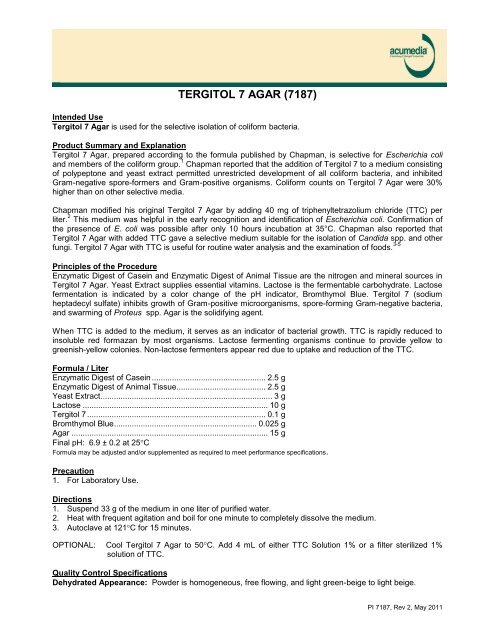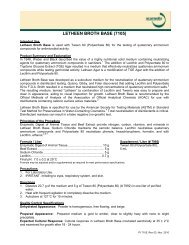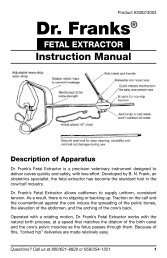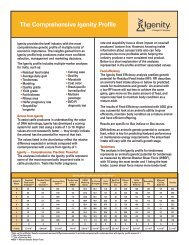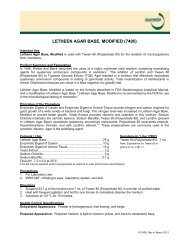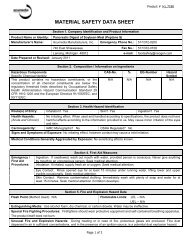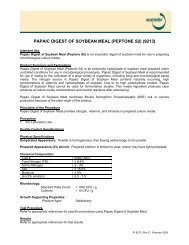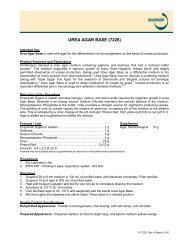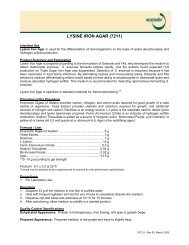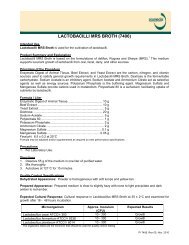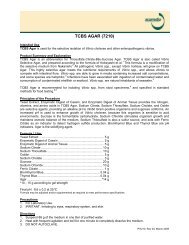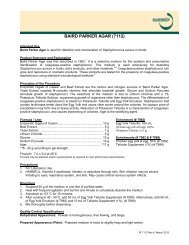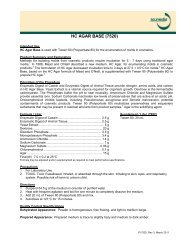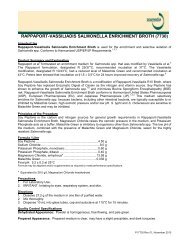Tergitol 7 Agar — 7187
Tergitol 7 Agar — 7187
Tergitol 7 Agar — 7187
You also want an ePaper? Increase the reach of your titles
YUMPU automatically turns print PDFs into web optimized ePapers that Google loves.
TERGITOL 7 AGAR (<strong>7187</strong>)<br />
Intended Use<br />
<strong>Tergitol</strong> 7 <strong>Agar</strong> is used for the selective isolation of coliform bacteria.<br />
Product Summary and Explanation<br />
<strong>Tergitol</strong> 7 <strong>Agar</strong>, prepared according to the formula published by Chapman, is selective for Escherichia coli<br />
and members of the coliform group. 1 Chapman reported that the addition of <strong>Tergitol</strong> 7 to a medium consisting<br />
of polypeptone and yeast extract permitted unrestricted development of all coliform bacteria, and inhibited<br />
Gram-negative spore-formers and Gram-positive organisms. Coliform counts on <strong>Tergitol</strong> 7 <strong>Agar</strong> were 30%<br />
higher than on other selective media.<br />
Chapman modified his original <strong>Tergitol</strong> 7 <strong>Agar</strong> by adding 40 mg of triphenyltetrazolium chloride (TTC) per<br />
liter. 2 This medium was helpful in the early recognition and identification of Escherichia coli. Confirmation of<br />
the presence of E. coli was possible after only 10 hours incubation at 35°C. Chapman also reported that<br />
<strong>Tergitol</strong> 7 <strong>Agar</strong> with added TTC gave a selective medium suitable for the isolation of Candida spp. and other<br />
fungi. <strong>Tergitol</strong> 7 <strong>Agar</strong> with TTC is useful for routine water analysis and the examination of foods. 3-5<br />
Principles of the Procedure<br />
Enzymatic Digest of Casein and Enzymatic Digest of Animal Tissue are the nitrogen and mineral sources in<br />
<strong>Tergitol</strong> 7 <strong>Agar</strong>. Yeast Extract supplies essential vitamins. Lactose is the fermentable carbohydrate. Lactose<br />
fermentation is indicated by a color change of the pH indicator, Bromthymol Blue. <strong>Tergitol</strong> 7 (sodium<br />
heptadecyl sulfate) inhibits growth of Gram-positive microorganisms, spore-forming Gram-negative bacteria,<br />
and swarming of Proteus spp. <strong>Agar</strong> is the solidifying agent.<br />
When TTC is added to the medium, it serves as an indicator of bacterial growth. TTC is rapidly reduced to<br />
insoluble red formazan by most organisms. Lactose fermenting organisms continue to provide yellow to<br />
greenish-yellow colonies. Non-lactose fermenters appear red due to uptake and reduction of the TTC.<br />
Formula / Liter<br />
Enzymatic Digest of Casein ................................................... 2.5 g<br />
Enzymatic Digest of Animal Tissue........................................ 2.5 g<br />
Yeast Extract ............................................................................. 3 g<br />
Lactose ................................................................................... 10 g<br />
<strong>Tergitol</strong> 7 ................................................................................ 0.1 g<br />
Bromthymol Blue ................................................................ 0.025 g<br />
<strong>Agar</strong> ........................................................................................ 15 g<br />
Final pH: 6.9 ± 0.2 at 25�C<br />
Formula may be adjusted and/or supplemented as required to meet performance specifications.<br />
Precaution<br />
1. For Laboratory Use.<br />
Directions<br />
1. Suspend 33 g of the medium in one liter of purified water.<br />
2. Heat with frequent agitation and boil for one minute to completely dissolve the medium.<br />
3. Autoclave at 121�C for 15 minutes.<br />
OPTIONAL: Cool <strong>Tergitol</strong> 7 <strong>Agar</strong> to 50�C. Add 4 mL of either TTC Solution 1% or a filter sterilized 1%<br />
solution of TTC.<br />
Quality Control Specifications<br />
Dehydrated Appearance: Powder is homogeneous, free flowing, and light green-beige to light beige.<br />
PI <strong>7187</strong>, Rev 2, May 2011
Prepared Appearance: Prepared medium is green and trace to slightly hazy.<br />
Expected Cultural Response: Cultural response on <strong>Tergitol</strong> 7 <strong>Agar</strong> incubated aerobically at 35 ± 2�C and<br />
examined for growth after 18 - 24 hours.<br />
Microorganism Approx.<br />
Expected Results<br />
Inoculum Response / colony Response / colony<br />
(CFU) color w/o TTC color w TTC<br />
Enterobacter aerogenes ATCC® 13048 10 - 300 Growth; yellow<br />
colonies<br />
Growth; red colonies<br />
Enterococcus faecalis ATCC® 29212 10 3 Growth; yellow- Marked to complete<br />
green colonies<br />
Escherichia coli ATCC® 25922 10 - 300 Growth; yellow<br />
colonies<br />
Pseudomonas aeruginosa ATCC® 27853 10 - 300 Suppressed to<br />
inhibited growth;<br />
blue colonies where<br />
recovered<br />
Salmonella typhimurium ATCC® 14028 10 - 300 Growth; blue<br />
colonies<br />
Staphylococcus aureus ATCC® 25923 10 3 Marked suppressed<br />
to inhibited; yellowgreen<br />
colonies<br />
where recovered<br />
The organisms listed are the minimum that should be used for quality control testing.<br />
Test Procedure<br />
Refer to appropriate references for specific procedures.<br />
inhibition<br />
Growth; yellow<br />
colonies (may have<br />
rust/orange center)<br />
Suppressed growth;<br />
red to blue colonies;<br />
blue halo<br />
Growth; red colonies<br />
w/ blue halo<br />
Marked to complete<br />
inhibition<br />
Results<br />
In the absence of TTC, E. coli produces yellow colonies with yellow halos; other coliforms produce yellow to<br />
yellow-green colonies. Non-fermenters produce blue colonies. With added TTC, E. coli produces yellow<br />
colonies; other coliforms produce yellow-green colonies, while non-fermenters produce red colonies.<br />
Storage<br />
Store dehydrated medium at 2 - 30�C. Once opened and recapped, place container in a low humidity<br />
environment at the same storage temperature. Protect from moisture and light by keeping container tightly<br />
closed.<br />
Expiration<br />
Refer to expiration date stamped on container. The dehydrated medium should be discarded if not free<br />
flowing, or if appearance has changed from the original color. Expiry applies to medium in its intact container<br />
when stored as directed.<br />
Limitations of the Procedure<br />
1. Some strains may be encountered that grow poorly or fail to grow on this medium.<br />
2. Pour plates do not give satisfactory results.<br />
3. Allow plates to dry with lids slightly ajar for 1 – 2 hours. 6<br />
4. Reduction of TTC is an irreversible reaction that produces an insoluble formazan compound.<br />
PI <strong>7187</strong>, Rev 2, May 2011
Packaging<br />
<strong>Tergitol</strong> 7 <strong>Agar</strong> Code No. <strong>7187</strong>A 500 g<br />
<strong>7187</strong>B 2 kg<br />
<strong>7187</strong>C 10 kg<br />
References<br />
1. Chapman, G. H. 1947. A superior culture medium for the enumeration and differentiation of coliforms. J. Bacteriol. 53:504.<br />
2. Chapman, G. H. 1951. A culture medium for detecting and confirming Escherichia coli in ten hours. Am. J. Public Health.<br />
41:1381.<br />
3. Kulp, W., C. Mascoli, and O. Tavshanjian. 1953. Use of tergitol-7 triphenyl tetrazolium chloride agar as the coliform confirmator<br />
medium in routine sanitary water analysis. Am. J. Public Health. 43:1111.<br />
4. Mossel, D. A. A. 1962. An ecological investigation on the usefulness of two specific modifications of Eijkman’s test as an element<br />
of the methods for the detecting of faecal contamination of food. J. Appl. Bacteriol. 25:20.<br />
5. Speck, Marvin L. (ed.). 1992. Compendium of methods for the microbiological examination of foods, 3rd ed. American Public<br />
Health Association, Washington, D.C.<br />
6. MacFaddin, J. F. 1985. Media for the isolation-cultivation-identification-maintenance of medical bacteria, vol. 1. Williams Wilkins,<br />
Baltimore, MD.<br />
Technical Information<br />
Contact Acumedia Manufacturers, Inc. for Technical Service or questions involving dehydrated culture media preparation or<br />
performance at (517)372-9200 or fax us at (517)372-2006.<br />
PI <strong>7187</strong>, Rev 2, May 2011


